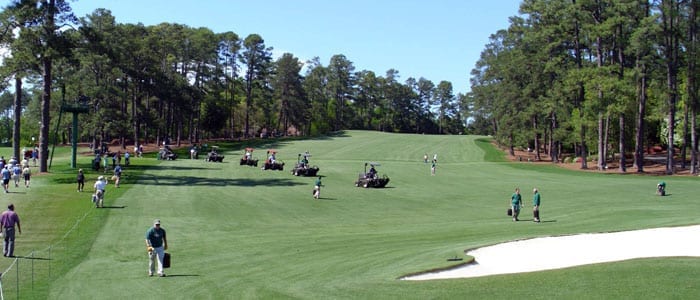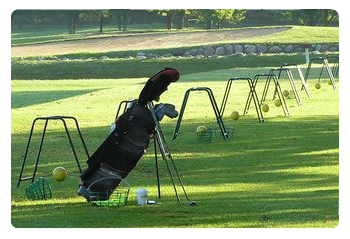
Our guest this episode is the Director of Golf at Mistwood Golf Club in Romeoville, Dan Phillips. Dan has a broad teaching background that has led him to study under a number of top golf teachers from around the country. In 2000 he was nominated as the Illinois PGA Teacher of the Year and he has also hosted his own nationally televised teaching program. To learn more, visit Mistwood Golf Club.
In this episode of The Chicago Golf Report Podcast, Dan talks about removing the unwanted “extras” in your golf swing so that you can develop a simple, consistent golf swing that is easy to repeat under pressure.
Podcast: Play in new window | Download
Subscribe: RSS
Interviewer: Walter Lis. Running Time: 22:22
Click here to download an MP3 file.
Click here to download a PDF file.
WL: Our guest this episode is the Director of Golf at Mistwood Golf Club in Romeoville, Dan Phillips. Dan has a broad teaching background that has led him to study under a number of top golf teachers from around the country. In 2000, he was nominated as the Illinois PGA Teacher of the Year and he has also hosted his own nationally televised teaching program. You can learn more about Dan and Mistwood Golf Club at mistwoodgolf.net.
Thanks for joining us today Dan. Your path to becoming a PGA instructor is somewhat unique. How did you get started?
DP: Well actually, I started pretty late in golf. I took my first lesson when I was 24 years old. I fell in love with the game. I fell in love with every part of the game from learning about the golf swing to the management of a golf course; everything that had to do with golf. Then, I had the opportunity, at 31, to become a golf professional and start teaching.
I started my career at the Remington Lakes Driving Range in Bolingbrook, which is now out of business, so the land was bought; and part of that range now, the clubhouse-the log cabin-is over at Bolingbrook Golf Club, along with the lights. There is a little history behind that.
From there, I worked at Hughes Creek Golf Club, in Elburn. That helped me so that I could enter the PGA; I had to work at a golf club for a while. From there, Michael Jordan’s Golf Range; I worked for a year there, teaching.
Since then, I have been at Mistwood for 11 years, now; I helped start Mistwood.
WL: What was the catalyst, at 31, to say, “Hey, this is going be the career path for me?”
DP: I just fell in love with it. The golf swing really intrigued me. I wanted to learn everything about it. There was so much written on it. I had taken some lessons from, I thought, some very good professionals, and in the back of my mind I always really wanted to be a teacher. I love sports. I love being outside. I played a lot of sports as a young man and golf just seemed like the natural place to go.
WL: Now, with your experience, and having over a decade of teaching; what is the one question that you get asked from most, say high handicap golfers? Secondly, what is the one question that you should be hearing from high handicap golfers?
DP: The major question that I get from golfers is that I want to be consistent. Consistency is the main, is the one thing that everybody asks for in golf. The problem is that they don’t think consistently. They will walk onto the golf course with 10 or 15 swing thoughts that are constantly changing their swing on the golf course. Where, if they walked on the golf course with just one swing thought and just carried that through the round of golf, the golf swing would find them; instead of them searching for it throughout the entire round of golf.
That is really where lessons come in. Our job, as teaching professionals, is to give you the most consistent, simplest swing that you can do. Golfers tend to have a lot of extras in the golf swing. Whether it’s coming out of posture, or maybe too much rotation in the hands in the backswing, or just a lot of little extras that are in there. What we try and do is get rid of those extras and keep all the good things that are in there.
Sometimes it feels like we are really doing a lot of changes; but actually the changes are taking things away that don’t work and leaving the good in there.
WL: You mentioned at the outset about the confidence and the consistency, in terms of the mental game; what do you try to work with your students on so that they are able to maintain that level of confidence and consistency throughout a round? Because, obviously, in 18-holes there are a lot of ups and downs.
DP: Golf itself can be a very frustrating sport. The thing is, we try and be perfect at a sport that is imperfect. For one thing, the surface that we are playing on is grass. It’s beautiful and it’s maintained, as all golf courses are, especially now. The grass is inconsistent. A putting green does have bumps on it. You can land in a little ball mark in a fairway and you might not even know it. So you have to take that for granted. Even the best players in the world are going to hit some bad shots.
I know that the best players in the world are not constantly in the middle of changing things. They really are trying to keep their focus on just one, maybe two things throughout the round. For a Tour pro, it may be a feeling of timing. For the rest of us, timing would be great; but normally we need some, or just maybe one, mechanical thought to bring us in there.
That takes work. It takes a few rounds of golf; going out on the golf course and just literally thinking one thing.
Let’s say, as a thought, I need to turn my shoulders. Well, as you are going through the round of golf, once you hit a bad shot, the first inclination is to think, “Well, maybe it’s my hands; maybe it’s my knee, maybe it’s this; or maybe it’s that.” You really have to stay away from that and just concentrate on that one thing that you brought on the golf course.
Which, let’s say its turn your shoulders; so with every shot that you take, the only thought that you can have would be, “For every swing, I’m going to turn my shoulders.” At the end of the round, the swing will normally come and find you.
If it really doesn’t, if you are just having a bad day; at least you can chalk that up to maybe a swing thought that just wasn’t the best for that day. Instead of going through a myriad of things and by the time you are done with the round you are just mentally drained and thinking that you’ve tried everything today and nothing works so I’m a really poor golfer.
WL: That’s really a great point that you bring up about sort of fiddling with the things that you bring to the course. I have that all the time, where I’ll go to the course; I’ll have my swing thought, or maybe a couple of swing thoughts; as soon as those stop working, my confidence goes down and I ‘m trying everything. I have a long laundry list of things that I will go through; but, like you said, everything gets confused. What would you suggest for somebody like myself who maybe questions themselves on an idea? Is it as simple as just saying, “Hey, this is what I’m bringing to the table today”, in terms of swing thoughts and sticking with them, or is it something else?
DP: Well, actually, it really is. Because if you think to yourself, “My goal is to be consistent; yes, I want to get better and I want to play well; but truly I want to be consistent.” If you don’t think consistently, you cannot be consistent. The problem is, once you do start changing a lot of swing thoughts on the golf course, you really stop playing golf and you start practicing golf. Well, that’s best left for the range; that’s your time really to practice golf. If you really don’t care what you shoot, you can go out and try anything you want on the golf course. But, at the end of the day, you really can’t add up your scorecard, because you haven’t really played golf; you’ve just practiced golf for 18 holes.
WL: So with your students, is that something you consciously work with them on in terms of creating a swing thought or creating a game that they can take in their head mentally to the course? Or is that all in their court?
DP: No, actually, I do a lot of work with that. With every student, I go through some swing changes; some things that would make them a better ball striker; more consistent. But, also, I go through some mental things with them on the golf course. Everybody thinks that the mental part is really just some magical place.
People talk about the zone and being in the zone, like it’s really mystical. It’s not. We’re in the zone probably 25 to 30 times a day. If you are driving your car, and you get there, and you don’t even really realize the turns that you took.
Let’s say you have driven the same route for 5 years; that’s being in the zone. If you’re watching a movie and you forget where you are; you are just so into the movie that you don’t even realize that you are in a movie theater at that point; that’s in the zone.
We are in there a lot more than we think and it’s easier to get into a place like that if we just stay; if our mind just stays focused on just one thing; we just keep trying that one thing instead of letting our mind wander.
WL: That’s a really interesting point, and I can attest that it is a lot easier said than done. I think it is almost a case of where you almost…and I would assume…I would like to have your opinion on that… Is it kind of a discipline that you develop throughout your playing? Being consciously aware of the fact of my mind is wandering and I need to get it back on track here.
DP: You do have to catch yourself sometimes out there. And just like practicing a pitch shot on the range; when you are going on the golf course and you are only taking one swing thought out there, it’s not going to work your first time. It may not work really well your second time. By your 3rd or 4th time, you are training yourself to do that and realizing that if I do change swing thoughts right now, it’s really not going to help me.
One of the things that happen when people change swing thoughts on the golf course is that they start out with one; they maybe play a couple good holes. All of a sudden, they maybe get some poor shots; so they switch up a swing thought and hit the ball great for another hole. Next hole-bad again, so they change thoughts, “It might be my knee this time, something with my knee.” Well, all of sudden that doesn’t work; try something else, try something else, try something else. The thing is, let’s just say that the third swing thought that you tried that day would be the absolute perfect thing for you to hit the ball well that day. The thing is, once you’ve changed it once, all it’s going to take is one slight mis-hit, or one semi-poor shot and you are going to change your thought again. So even if you do find the perfect swing thought, you’re not going to stick with it.
WL: It’s a very good point. That’s interesting. I notice that when you see a higher level of player; so say for example, you have a college event and you see these young college players out there and that’s a very good point to think about. What is their train of thought? They seem to have such a technically beautiful swing and they are able to maintain consistency and, gosh, they are so young. I’m wondering, what about all these swing thoughts I have in my head? They probably don’t have that. It is probably much simpler for them to continue what they have been doing for the last 4 or 5 years, and doing so well.
DP: A lot of it is youth. Just as I was willing to jump off the top of my garage when I was maybe 20 or 21 years old or something like that, or maybe a little bit younger; now at 50, there is no way I’m even going to get on the garage. There are a lot of different fears. By the time you get older, you know all of those things that can happen, and you have a little bit of fear when you are going out there.
In youth, you are looking at a 20-foot putt, or something, and just feel like you are going to drain it and you seem to hit it without fear a little bit firmer and it goes in the hole. With a little more fear you tend to be a little more tentative, and you’re going to miss the putt. There is that youth that where they get a little gutsier and maybe a little more confidence, maybe a little cockiness.
That’s basically what you see in your Tour players. When they are out there, they believe they are the best. They believe that no one is going to beat them. Tiger portrayed that for years; and it slipped out once when he won a tournament early in his career and he said, “Well, I really had my ‘C’ game today, my ‘B’ game.” It didn’t make the other players feel well that Tiger just beat them with what he considered to be his “C” game. But, in his mind, he can beat you with his “C” game, his “B” game, His “D” game. Really, he knows he is going to win no matter what.
WL: You have the privilege of hosting some of the top players from the top women’s players, with the Phil Kosin Illinois Women’s Open that comes in towards the end of July. Can you talk a little bit about that event? And hosting that event? I believe Mistwood has hosted it for a number of years now. What does that mean to women’s golf, Illinois’s women’s golf, and Mistwood in general?
DP: Mistwood is really proud to host the event. We have been blessed enough to have the event for going on 9 or 10 years now. The women that come out are just really classy players. It is just a pleasure to be around them. From a teaching standpoint, just watching them hit the golf ball…I mean, there are some ladies out there with some tremendous golf swings…And watching them play is a really a treat. A lot of them are playing at such a high level that you have to get under par to win the tournament. Mistwood is not considered, in the area, as one of your easier golf courses. These girls can flat out play.
Our relationship with Phil Kosin was long. We have a lot of respect for Phil. Phil started the tournament; he knew that here was a place for ladies to have something in Illinois. With his passing, his family has entrusted us with hosting the tournament. We are just really, really pleased to do it.
We are trying to make the tournament a little bit larger every year, from now on. The prize money is good for the professionals and the amateurs. It is a lot of prestige to win this tournament. We have had both professionals and amateurs win it. We’ve had LPGA players come out here and play in it. We’ve had Futures Tour players come out and play in it. It’s a very high level of golf and if you come out and watch it, you really will learn something. You will really enjoy your time out here watching the tournament.
WL: You know one of the things I tell people too, for me, as an amateur golfer is that I find that, especially in an event like that; watching women play, for me, seems to be more doable in terms of most of the time they are not over swinging. It doesn’t seem like they are really super-human, like you can see with some of the PGA players. They have more of a, like you said, more form; more consistency; more stability that I can relate to and almost gives me hope, saying, “Wow, look what they can accomplish with such a simple move.” It doesn’t seem like it’s superhuman.
DP: I understand exactly what you are saying. If you go out and watch a Tour event now, some of these guys are getting so big and their club head speed is so fast that it’s almost hard to pick up some of the things that they are doing. The ladies, on the other hand, are generating some very good club head speed and they are hitting it further than they ever have. It’s usually in a smoother package and actually a lot more pleasing to the eye. If you really look at it, you can see a little bit more of what is going in the golf swing. And they do it gracefully, which is fun to watch.
WL: Now the other thing about Mistwood is that is very unique in terms of from an outsider’s perspective. You have your owner being up front and people being able to see him; and then you also have different events that are very unique. One of the really unique ones is the Crosstown Classic. Can you talk a little bit about that and where it started and now where it has grown into? I know you have some different videos posted online that are amazing! The amount of effort that must go into putting an event together like that.
DP: Just a little bit about the owner first; he took over the golf course about 5 years ago and has been a real advocate of the golf course. We have added tees; we have changed bunkers; we have redone a green. We still have more work that we want to do to make this course even better. We are not standing on our laurels. We just keep moving along, along with what looks like a new clubhouse project that should be starting maybe at the end of this year or beginning of next year. He does allow us to do to do what some people may call some of the crazy things that we do as far as tournaments.
The Crosstown Classic takes 2 or 3 months of preparation; along with us doing it for some years, we’ve been able to accumulate some of the things that we have. It is a lot of preparation, but that’s what makes it a lot of fun. We have a sunflower seed spitting contest. We have a base-throw contest. We had an old-time putting competition that reminded me of the old baseball game on the wood…It’s like a game that you play with marbles on wood and you kind of shoot it.
We produced one of those on our putting green and we had a long line of guys trying to do that.
We shoot balls at them on the 3rd hole, and if they catch it they get a raffle ticket. We have a hole where we razz them. We actually called up [a nurse 0:20:25.6]… So if you were playing with another person, we would call that person and ask them for some inside information so that when they got to where they would be putting on the green, we were yelling stuff and doing things that these people didn’t even, like if…One example, a guy was a banker that we found out from his friends so we were out there making banking jokes. They really enjoyed it. I mean, we were razzing them and it was a lot of fun.
At a lot of tournaments, the food is fantastic. A lot of different events on the golf course. We decorate the course. This year, we had some skydivers come in for the first time. After the National Anthem, we had five skydivers come in and skydive onto the range.
We go all out. I don’t know if we make any money at it, but we sure have lots of fun!
WL: There are not too many events in the area that have goats and skydivers at the same time on the course.
DP: Yeah, you don’t see too many goats at a golf event! What is amazing, too, is when you are trying to hit a golf ball on the range and you hear a goat making noises out there, you are like, “I’ve never hit a golf ball next to a goat before! This is pretty interesting!”
WL: That’s a lot of the stuff that gives Mistwood a lot of character and makes it that…In addition to the big events, like the Illinois Women’s Open that is coming up, really give it a lot of character. Yeah, it’s very interesting!
Have a great day, and we will talk to you later.
DP: Thanks, Walt.
WL: Take care.
This has been the Chicago Golf Report podcast. Visit chicagogolfreport.com right now for exclusive discount offers, Chicago golf news, and in-depth event listings.







 Find a Golf Course
Find a Golf Course Find a Driving Range
Find a Driving Range Find a Topgolf
Find a Topgolf Find a Golf Instructor
Find a Golf Instructor